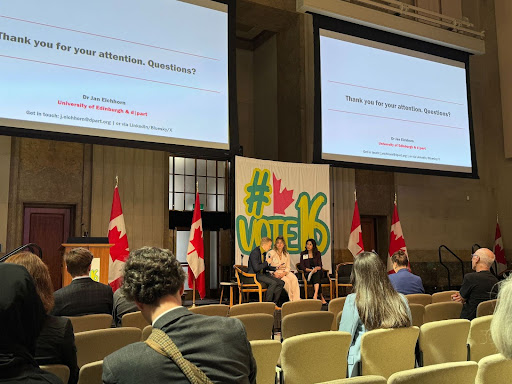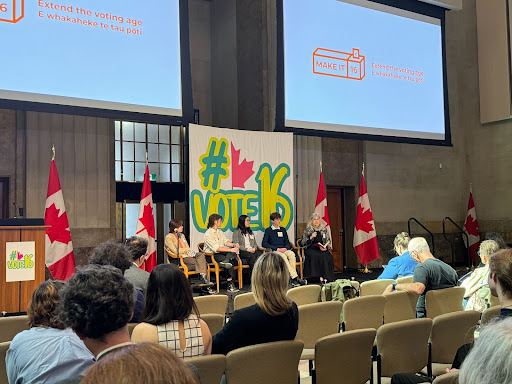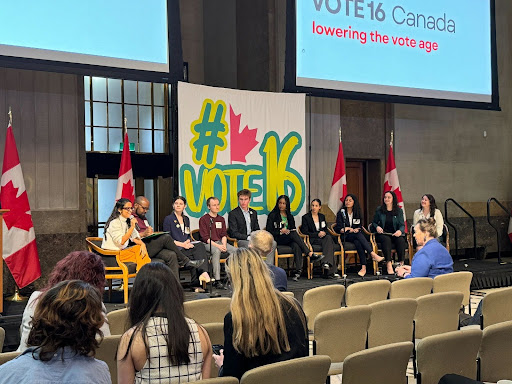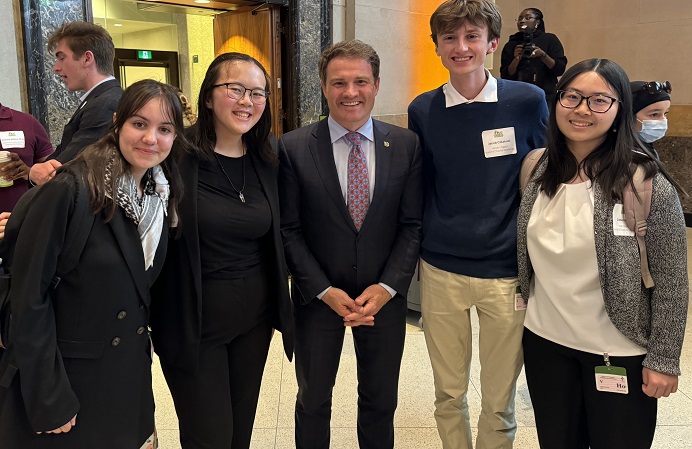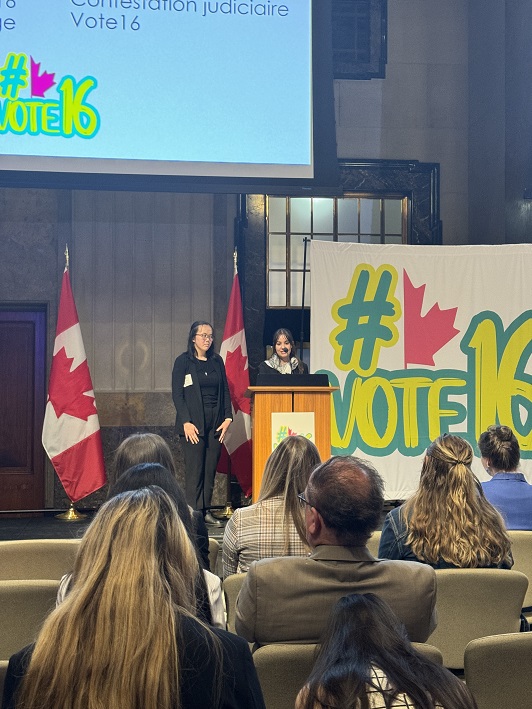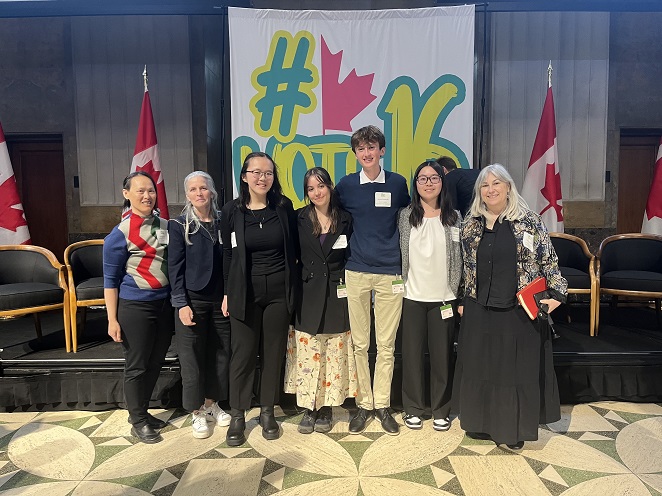by: Chelsea Gordon and Daniel Kiesman
For the first time in Canada, an appellate court has considered the implications of the Canadian Charter of Rights and Freedoms (“Charter”) on climate change policy. In a decision released on October 17th, the Ontario Court of Appeal allowed the appeal in Mathur v Ontario[1] and remitted the application to be heard again by the Superior Court. In doing so, the Ontario Court of Appeal identified errors in the lower court judge’s analysis of the appellants’ case under ss. 7 and 15(1) of the Charter. This decision represents a significant win for youth climate activists.
The Asper Centre, represented by Ewa Krajewska, intervened in this case at both the Superior Court and the Court of Appeal.
Background
Superior Court Judgement
In the judgement on appeal at the Ontario Court of Appeal, a Justice of the Superior Court rejected the applicants’ constitutional challenge to the greenhouse gas emissions target set by the Government of Ontario under s. 3(1) of the Cap and Trade Cancellation Act (“CTCA”).[2]
In 2018, the Government of Ontario, through s. 3(1) of the CTCA set an emissions reduction target of 30% below 2005 levels by 2030. However, scientific research showed that to prevent serious adverse consequences, greenhouse gas emissions would need to be reduced by 52% below 2005 levels by 2030. The applicants are a group of young Ontarians who argued that the target set by Ontario was too low, leading to adverse future consequences for young people and future generations.
At the Superior Court, the applicants advanced two Charter arguments. First, by failing to set the target high enough, Ontario was authorizing and creating a level of emissions that will lead to serious adverse consequences and put the lives of Ontarians at risk, violating s. 7 of the Charter. Second, the applicants argued the CTCA violates s. 15(1) of the Charter because it distinctly encumbers young people and future generations who will endure most of the impacts of climate change.
The judge characterized the applicants’ complaint as being a positive rights claim, suggesting that the applicants were seeking a declaration that the Ontario government has a positive obligation to prevent the impacts of climate change from posing a threat to young people’s security of the person.[3]
You can read the Asper Centre’s Superior Court factum here. For a more in depth discussion of the Superior Court decision, please see the Asper Centre’s previous blog post here.
After framing this as a positive rights case, the judge went on to assume without deciding that a positive obligation arose in this case, but that Ontario did not violate the principles of fundamental justice when setting the emissions target.[4] On that basis, no violation of s.7 was found. In deciding the applicants’ s.15(1) claim, the judge applied the two-part test from R v Sharma.[5] She held that while young people are disproportionately affected by climate change, that disproportionate effect is caused by climate change itself and not by the emissions target set by Ontario.[6] On this basis, she found that the government of Ontario had not caused or contributed to the disproportionate effects of climate change faced by young people. Further, there is no positive obligation on the government to address inequalities through remedial legislation.
Arguments on Appeal
The applicants appealed the Superior Court decision alleging that the application judge erred by characterizing their ss. 7 and 15(1) Charter claims as attempts to impose positive obligations on the Government of Ontario to combat climate change. Their position was that Ontario’s chosen response to climate change knowingly permits dangerously high levels of greenhouse gas emissions, which will discriminate against youth and future generations, and that both the Target and the Plan should be reviewed for constitutional compliance.
Ontario focused its arguments primarily on the issue of remedies, arguing that the appellants’ request for a science-based greenhouse gas reduction target was outside the court’s institutional capacity to order. Further, Ontario argued that the appellants’ have not proven that Ontario has caused or contributed to the worsening impacts of climate change and that the effects claimed are not caused by the Target, Plan or the CTCA.
Asper Centre Intervention
The Asper Centre intervened on two points. First, the application judge erred by adopting a formalistic approach to causation that has consistently been rejected by the s. 15(1) jurisprudence. Second, given the complexities and the novelty of climate change, should the Court of Appeal find a Charter infringement, it ought to go beyond declaratory relief to craft an appropriate and just remedy under s. 24(1) of the Charter. You can read the Asper Centre’s factum here.
With respect to s. 15(1), the Asper Centre urged the Court of Appeal to reinforce the flexible approach to causation in the context of governmental emissions targets. The Asper Centre emphasized that the caselaw has made clear that substantive equality is at the centre of s.15(1). To achieve substantive equality, courts must adopt a flexible approach to causation and consider the actual impact of the impugned law on the claimant group. Claimants need not show that the impugned law is the only or predominant cause of the disproportionate impact. Under the proper approach to causation, the claimants need only to show that the impugned emission targets contribute to the disproportionate effects of climate change. In this way, substantive equality may be achieved by allowing s. 15(1) to remain flexible to account for pre-existing problems such as climate change.
The Asper Centre also argued that the application judges’ approach, which viewed climate change itself as the cause of the disproportionate impact on youth, harkens back to the rejected formalistic approach to equality taken under the Canadian Bill of Rights. Instead, the Asper Centre argued that the application judge should have followed the approach to substantive equality taken by the Supreme Court of Canada in cases like Quebec (Attorney General) v. Alliance du personnel professionnel et technique de la santé et des services sociaux and Quebec (Attorney General) v A.[7] These cases recognized that while the government was not responsible for the underlying inequality, all that the claimant must show is that the government action contributes to a disproportionate impact.
With respect to s. 24(1) remedies, the Asper Centre argued that if a Charter violation is found, the Court can be creative in utilizing its remedial discretion under s. 24(1). The Asper Centre argued that, in this case, declaratory relief would be insufficient since the impacts of climate change and inadequate government action present complex and novel issues for the legal system. The Asper Centre submitted that when faced with novel issues, courts are able to fashion unique remedies under s. 24(1).
For a more fulsome discussion of the Asper Centre’s intervention before the Ontario Court of Appeal, please see our previous post here.
Decision of the Ontario Court of Appeal
In a unanimous decision, the Ontario Court of Appeal held that the application judge erred in characterizing this as a positive rights case. They stated, “Ontario voluntarily assumed a positive statutory obligation to combat climate change and to produce the Plan and the Target for that purpose. Ontario was therefore obligated to produce a plan and a target that were Charter compliant.”[8] The Justices allowed the appeal owing to the errors in the lower court judgement but declined to decide the issues and instead remitted it back to the Superior Court to be heard again. They chose not to decide the issues based on the “institutional advantage” that courts of first instance have in issuing declarations and directions.[9]
Section 7
In the s. 7 analysis, the Ontario Court of Appeal found that the application judge’s incorrect framing of the issue as a positive rights claim has led to errors in her reasoning. The Court stated, “The question before the application judge was not whether Ontario’s Target did not go far enough in the absence of a positive obligation to do anything. Rather, she should have considered whether, given Ontario’s positive statutory obligation to combat climate change that it had voluntarily assumed, the Target was Charter complaint.”[10]
Section 15(1)
The Court held that the application judge had again erred by characterizing the appellants’ claim as a positive rights claim. In the case of s.15(1), this led the application judge to incorrectly conclude that the applicants sought to impose an obligation on the government to remedy inequality associated with climate change. The Court of Appeal emphasized that while s. 15(1) does not impose a general obligation on the state to remedy all inequalities, when a government has chosen to act, that legislation cannot have a discriminatory impact.[11]
The Ontario Court of Appeal held that the application judge’s analytical error in construing the appellants’ position as a positive right claim led to an improper causation analysis. The Court’s reasons indicate that the causation analysis at the first step of the s. 15(1) test should be flexible and responsive to the nature of the particular adverse impact claim. Thus, the Court of Appeal held that proper causation analysis in this instance should have gone further and considered whether, by committing itself to a greenhouse gas emissions target that fell short of the scientific consensus on what was required, Ontario has caused or contributed to a disproportionate impact.[12] Because the province has chosen to enact the CTCA, the proper analysis should have addressed whether “there was a link or nexus between the impact of the Target and the disproportionate impact based on a protected ground.”[13]
Additionally, the Court of Appeal determined that the application judge’s causation analysis was at odds with her findings under s. 7.[14] The application judge held that the appellants had met their causation burden of showing the CTCA engaged their rights to life and security of the person. The Court of Appeal noted that the causation burden under both s. 7 and s. 15(1) is the same in that a claimant does not need to show that state action is the dominant cause of the harm.[15] By finding that the causation burden was met under s. 7 and not under s. 15(1), the application judge drew conclusions which the Court of Appeal determined were inconsistent and not adequately explained.[16]
Implications Moving Forward
The Court of Appeal declined to decide the application and instead remitted the case back to the Superior Court for a new hearing.[17] Thus, the case will return to the Superior Court for the s. 7 and s. 15(1) issues to be decided on the merits and in light of this decision.
Overall, this decision is an important signal that Charter challenges of climate change legislation are not necessarily positive rights claims. In this case, the Court of Appeal made clear that while climate change is a global issue when a provincial government chooses to act to address it, the choices it makes are subject to review to ensure they are compliant with the Charter. Going forward, this case solidifies the role of the judiciary with respect to climate change and other remedial legislation. Ensuring that in the division of powers, the judiciary will maintain a role in reviewing legislation for constitutional compliance and, more than anything, leaves open the door to a finding that insufficient climate change action violates Charter rights.
This decision is also important as it is one of the first appellate decisions regarding s. 15(1) since the Supreme Court released its decision in Sharma.[18] The Court of Appeal recommitted to the flexible approach to causation that a substantive approach to equality requires. This decision makes clear that a rigid and formulaic approach to causation is improper and inadequate. Where a pre-existing societal inequity exists, and a government chooses to act to address it, courts must not focus only on pre-existing inequity at the causation stage of the analysis. Instead, as the Court of Appeal indicated in its reasons, courts must adopt a flexible approach to causation that considers the underlying contextual factors and examine whether the government action in question contributes to the inequality in question. In this instance, as the Court of Appeal concluded, the proper approach to causation necessitates an inquiry into whether the impugned emissions targets contribute to a disproportionate impact on youth.[19]
Chelsea Gordon and Daniel Kiesman are 3L JD Candidates at the Faculty of Law, and were Asper Centre Clinic students in Fall 2023, who worked on the Asper Centre’s intervention in Mathur.
[1] Mathur v Ontario, 2024 ONCA 762 [Mathur CA].
[2] Mathur v Ontario, 2023 ONSC 2316 [Mathur]; Cap and Trade Cancellation Act, 2018, SO 2018, c 13, s 3(1).
[3] Mathur, supra note 2 at paras 122-124.
[4] Ibid at para 142.
[5] R v Sharma, 2022 SCC 39.
[6] Mathur, supra note 2 at para 178.
[7] Quebec (Attorney General) v. Alliance du personnel professionnel et technique de la santé et des services sociaux, 2018 SCC 17; Quebec (Attorney General) v A, 2013 SCC 5.
[8] Mathur CA, supra note 1 at para 5.
[9] Ibid at para 7.
[10] Ibid at para 53.
[11] Ibid at para 40, 55-58.
[12] Ibid at para 58.
[13] Ibid at para 57.
[14] Ibid at para 59.
[15] Ibid at para 61.
[16] Ibid at para 65.
[17] Ibid at para 76.
[18] R v Sharma, 2022 SCC 39.
[19] Mathur CA, supra note 1 at para 58.

